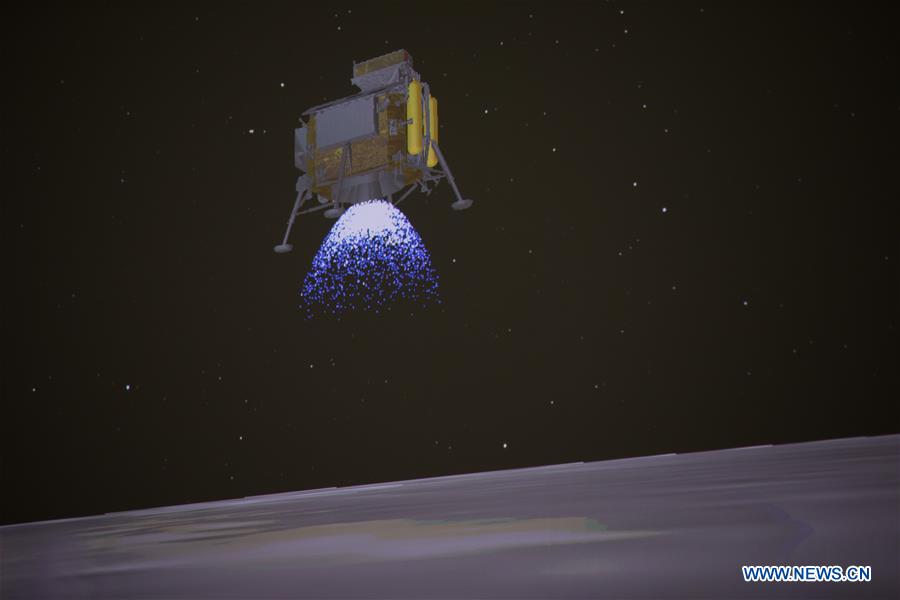


A simulated landing process of Chang'e-4 lunar probe is seen through the monitor at Beijing Aerospace Control Center in Beijing, capital of China, Jan. 3, 2019. (Xinhua/Jin Liwang)
China's Chang'e-4 lunar probe has made the first-ever soft landing on the far side of the moon. Experts believe that this successful landing has opened a new chapter in mankind's lunar exploration.
A lander, rover and relay satellite named Queqiao jointly completed the landing, and now serve to communicate between the moon and Earth, said Sun Zezhou, chief designer of the Chang'e-4 probe, from the China Academy of Space Technology.
The mission has conquered at least three difficulties so far. The first was to position the Queqiao relay satellite at the second Lagrangian (L2) point of the Earth-moon system, about 79,000 km from the moon and 40,000 km from Earth, where it can see both Earth and the moon's far side.
The second, Sun said, was to guarantee the accuracy and reliability of the relay satellite for moon-Earth communication and to access the probe's control system.
The third was the safe landing of the probe in the designated area, which has many geological features, said Wu Weiren, the chief designer of China's lunar probe program. To land safely, the probe had to choose a flat area at a big collision site on the far side of the moon.
The probe descended vertically towards the Von Karman Crater in the South Pole-Aitken basin, Wu said. When it fell to an altitude of about 2 km, its computer identified and assessed large obstacles such as rocks and craters so that the probe could avoid them.
At 100 meters above the ground, the probe hovered to identify smaller obstacles and measured surface slopes. Its computer recalculated and selected the safest site.
“If the probe couldn’t find a safe landing area, it would have kept adjusting itself until a relatively safe spot was found,” Sun introduced.
The probe landed at the preselected landing area, 177.6 degrees east longitude and 45.5 degrees south latitude, on the far side of the moon. The thermal control system and solar wings of the probe were designed to be in line with these conditions.
The Aitken Basin is the largest, deepest and oldest known crater in the solar system. About 2,500 kilometers in diameter and 12 kilometers in depth, it has a small crater, Von Karman, inside it.
An alternative landing area had also been prepared. If the Chang’e-4 probe failed to touch the surface of Von Karman on the first day, it could have landed at the alternative location on the second day.
Sun said more functions were attached to the design of the Chang’e-4 mission so that the probe would be able to carry out more challenging tasks.
For instance, the sensor capabilities were enhanced for more accurate guidance and navigation while the probe was descending. Scientists also adjusted strategies for the landing process and control targets of each part of the landing mission.
The probe was made to become independent. While the probe works on the moon, it can “sleep” during the lunar night and “wake up” in the day, to begin its work on the moon surface.
The mission is a massive contribution to China’s global strength in the aerospace industry. In the future, the country will carry out a number of these missions.
 Fire brigade in Shanghai holds group wedding
Fire brigade in Shanghai holds group wedding Tourists enjoy ice sculptures in Datan Town, north China
Tourists enjoy ice sculptures in Datan Town, north China Sunset scenery of Dayan Pagoda in Xi'an
Sunset scenery of Dayan Pagoda in Xi'an Tourists have fun at scenic spot in Nanlong Town, NW China
Tourists have fun at scenic spot in Nanlong Town, NW China Harbin attracts tourists by making best use of ice in winter
Harbin attracts tourists by making best use of ice in winter In pics: FIS Alpine Ski Women's World Cup Slalom
In pics: FIS Alpine Ski Women's World Cup Slalom Black-necked cranes rest at reservoir in Lhunzhub County, Lhasa
Black-necked cranes rest at reservoir in Lhunzhub County, Lhasa China's FAST telescope will be available to foreign scientists in April
China's FAST telescope will be available to foreign scientists in April "She power" plays indispensable role in poverty alleviation
"She power" plays indispensable role in poverty alleviation Top 10 world news events of People's Daily in 2020
Top 10 world news events of People's Daily in 2020 Top 10 China news events of People's Daily in 2020
Top 10 China news events of People's Daily in 2020 Top 10 media buzzwords of 2020
Top 10 media buzzwords of 2020 Year-ender:10 major tourism stories of 2020
Year-ender:10 major tourism stories of 2020 No interference in Venezuelan issues
No interference in Venezuelan issues
 Biz prepares for trade spat
Biz prepares for trade spat
 Broadcasting Continent
Broadcasting Continent Australia wins Chinese CEOs as US loses
Australia wins Chinese CEOs as US loses